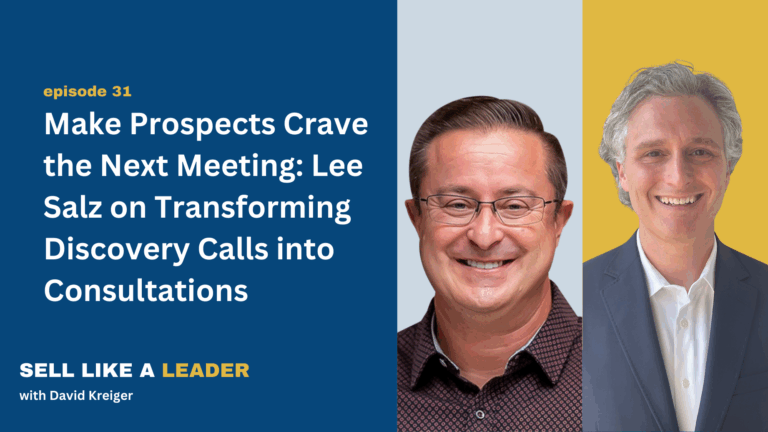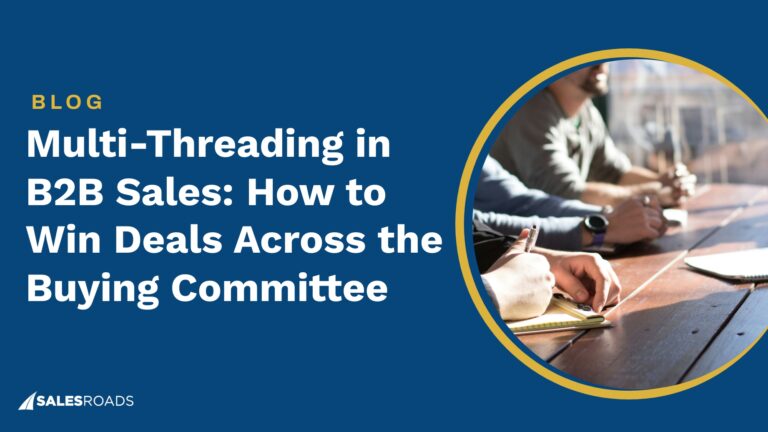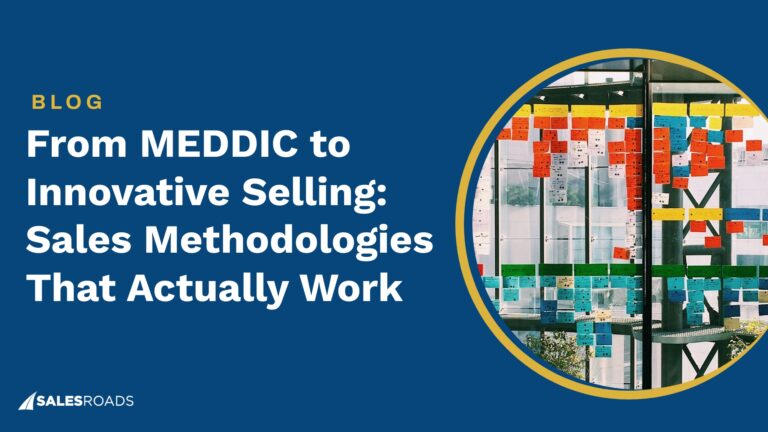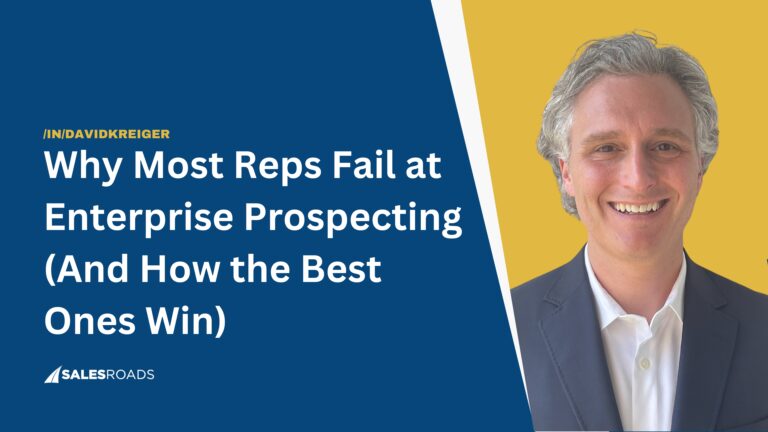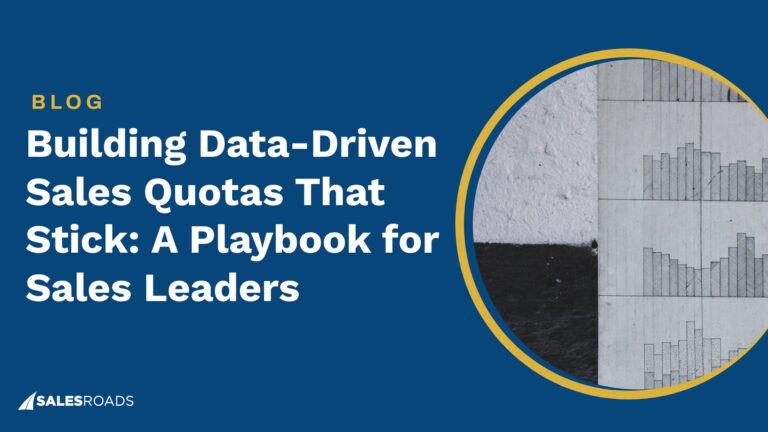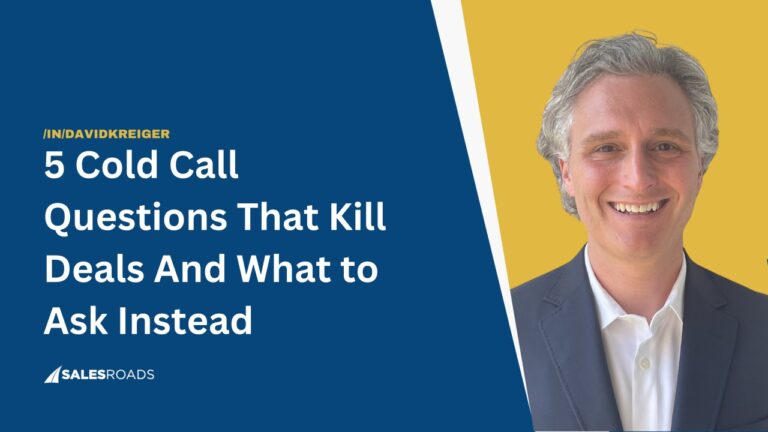Sell Like A Leader – Episode 20
In this episode, we dive into:
– Conversation Intelligence (CI) and Revenue Intelligence (RI): The origin story of business intelligence, Gong and conversation intelligence, the market pivot that made CI a necessity, the different adoption phases, how to assess basic adoption vs. applying a higher level of analysis, evaluating sales behaviors objectively, forecasting with lot more science than humans could, transforming pipeline reviews meetings, making coaching good for the seller and the manager, lifting win rates, internal and external obstacles to using CI tools, aligning the implementation of CI and RI tools with your organization’s cultural values to facilitate acceptance and utilization, and effective dashboard design.
– Rapid Fire Q&A
About Danny Wasserman
David Kreiger chats with Danny Wasserman, a former restaurateur turned Enterprise SaaS seller and currently a leader at Databricks. He has researched, architected, and delivered sales enablement content that globally serves SMB, Commercial, Enterprise, Partner, and Customer Success teams. Whether in front of the room facilitating, in the studio hosting a podcast, or in the back office ghostwriting communications for executives, Danny remains equally committed to always playing for the team and never losing sight of humility.
Podcast Key Takeaways
- CI tools go beyond simple call tracking by identifying key behaviors, keywords, and conceptual articulation during sales interactions. This ensures that sales reps are applying new strategies as intended.
- Leveraging CI data, revenue intelligence enhances deal reviews and forecasting by identifying successful opportunity elements like pain points and competitive factors. It streamlines decision-making, improving accuracy and efficiency.
- CI tools highlight coaching opportunities, such as addressing gaps in budget discussions or engaging senior decision-makers, increasing the likelihood of closing deals.
- Enhanced processes reduce wasted time in pipeline reviews, strengthen manager-rep relationships, and focus on strategy.
Connects
Connect with Danny Wasserman: https://www.linkedin.com/in/dannybwasserman/
Connect with David Kreiger: https://www.linkedin.com/in/davidkreiger
Subscribe to the podcast and follow our Podcast LinkedIn page so you don’t miss any episodes!
Transcript
David: Welcome back to another episode of the Sell Like a Leader podcast, the podcast for revenue leaders who are on a mission to cultivate a high-performing sales team. I'm your host, David Kreiger, founder of SalesRoads, America's most trusted sales, outsourcing, and lead generation provider.
And today, I'm excited. We've got an awesome sales leader, Danny Wasserman, who actually was recommended by another awesome guest, Bob Spina. They worked together. Bob said that Danny was the right hand, the person who helped him build the enterprise group at Gong, and he just couldn't sing his praises enough. He's got an awesome background which I guess evidently started as a restaurateur.
But currently, he is a leader at Databricks, which is like lighting it up right now, and it's really just one of those amazing companies that's on fire. [00:01:00] So thanks for being on the show.
Danny: David, thanks for having me on. Quite the intro. I just want to calibrate everyone's expectations. Whatever David just shared or whatever Bob was telling you, let's just calibrate your level of disappointment that you're about to endure for this episode.
David: One skill I didn't mention was modesty. So there we go, Danny. Well, let's jump in. It's part of our pre-research. One of the things that you have said and, your approach to cultivating high-performing sales teams involves the adoption of conversation intelligence. It's interesting 'cause you put two concepts together, right?
Conversation intelligence and revenue intelligence. And I think so for the folks listening, could you just define what those are from your perspective, and maybe just give us some examples.
Danny: Yeah. If we go back and rewind the clocks, actually probably even worth describing the history of business intelligence, because that had a ton to influence the genesis of Gong. So the CEO and [00:02:00] co-founder, Amit Bendov, at one point in his career was actually a C-suite executive for a company called Sisense.
So for those who aren't familiar with Tableau or Sisense or Power BI, this is the business intelligence domain where you take raw data in any number of forms and you visualize it. And that visual is a much more intuitive way for humans cognitively to understand the story that is typically embedded in these rows and columns of data.
So Amit says, okay, we're looking to unearth insights in business intelligence. And yet, even at a place like Sisense, where we're a BI company, he had a quarter where things went sideways. He went to CRM, he went to his BI solutions and was left empty handed. So much of the story was a black box of what actually took place in the conversation between the rep and the customer.
So he crossed that chasm by being like I'm a musician when I'm not working at Sisense. I can make unbelievable recordings in [00:03:00] my garage with GarageBand, which is standard issue software on my MacBook Pro. Why are we not applying the same access of recording capabilities to these conversations that left me befuddled, just completely bewildered as to what happened in my quarter.
And that was the genesis of really Gong and CI. As CI has become thanks to the unexpected accelerant of COVID and sales leaders almost overnight needing to know what their five or a dozen reps were doing who previously all worked in the same row in an office, all of a sudden CI goes from being something that's a little Big Brother-y, it's a little creepy, it's paranoia-inducing, now all of a sudden it's a necessity.
And then you see a huge market pivot away from being like, ah, who the hell needs that? Get this monkey off my back, you gong recorder. To now all of a sudden, if you're a leader and you want to know what's happening in that last mile, CI is the way that you can scientifically and more objectively and [00:04:00] impartially capture what takes place.
And then again, we'll get to the next phase of that evolution, which is moving beyond simply what you can do to coach from these recordings, what you can do to glean what's actually transpiring in the last mile that was always a black box, to now embedding those insights upstream into your prospecting and downstream into your forecasting. And that confluence of those revenue functions is that next phase of not CI, but instead RI.
David: And so to dig into the CI part initially, so if I'm a sales leader listening to this podcast, how would somebody assess their current adoption of conversational intelligence? And obviously, there's those who have Gong and layers within that and how they can adopt it.
Some that are just listening to calls, some that aren't. Like, how would you, if you were walking into a new sales organization, give them a sense or assess what they're doing around conversational intelligence and whether they're using it in the right way.
Danny: For sure. [00:05:00] First and foremost, there's just a binary. Do you have a CI tool in place? And if not, like what is your level of resistance or reluctance to want to start recording those interactions? Is it because you think your customers are going to bristle and chafe at it? Maybe because you operate in a regulated industry and maybe that's not on the table, or is it an internal reluctance that it just feels, ah, but we've sold without it for this long.
Why do we need to make that kind of quantum leap? And I think the reality is taking stock psychologically of either where your customers and/or your internal personnel are is the first step.
The next step is imagine you do have a CI tool and it doesn't need to be Gong. And as a former employee and shareholder there, it pains me to admit becoming more and more commoditized.
So it's not only like I'd say a gong show, I'd say that it's even more than a two-horse race between Gong and the next equivalent solution. It's everywhere. And again, table stakes would be whether [00:06:00] it's Gong or whether it's Clari's solution, which is called Wingman, whether it's Outreach and Kaia. I don't really have a dog in the fight anymore about that.
It's, are you at baseline able to aggregate enough call volume and critical mass of your sellers piping data through your solution so that you can begin to isolate trends? What are the things that you're hearing would be first and foremost. Hey, like we espouse or we hypothesize, this is what a good first call looks like. This is what it sounds like.
Do you see evidence of that in the wild? That's I think just phase one, because you can't be at eight places at once. You want to know what's actually taking place in that black box. The next phase would then be, okay, we can see that there's adoption. There is utilization of our hypothesis.
Was our hypothesis even right? And historically, before you had CI, there'd be a ton of political emphasis placed on this is our new message, or this is our new product, or we're going to market in a new place that [00:07:00] we've never sold before.
We don't know if our pricing is going to work. Any number of variables or questions that you can't understand until you're actually there to validate whether or not that was a good bet to place was entirely reliant on lagging indicators and misleading, highly subjective data collection.
You would go around and you would pulse leaders arbitrarily, maybe some that had a bias or maybe some that were inherently unnerved by telling you the God's honest truth that your hypothesis sucked because they knew that there would be backlash politically or would jeopardize their career. You're really operating with a fraction of the truth.
And now, with CI, more than just seeing is something being adopted, more than just being able to coach those reps who aren't applying it when they should be, now because it's integrated with your CRM, you can see when the behavior that you expect and then subsequently inspect is being applied. Are we seeing more than just behavioral change?
Are we seeing impact? And that gets to the Kirkpatrick models of L1 through [00:08:00] 4 of enablement's role in organizations. Do we see win rates go up? Do we see sales cycles get compressed?
And that's, I'd say, the next phase and even just your CI adoption. We're not even thinking about how we apply that winning behavior that creates the impacts that you report back to the board on upstream to your prospecting sequences or downstream to how you do deal reviews and forecasting with your CFO.
David: Yeah. I want to ask one more question on conversational intelligence. And then I really want to unpack the whole revenue intelligence, 'cause that feels like the conversational intelligence is the master’s, and then the PhD is revenue intelligence.
And I'm curious if you agree with this. I think a lot of companies will adopt a Gong but they'll use it almost just as you could have used a basic recording solution that you could get from Five9 or something out of the box. It has nice coaching tools and ways you can put your notes in and listen, that's good because there are organizations that don't even do that, but it feels like that's where [00:09:00] the adoption for a lot of companies ends, which again, is a good thing.
It's better than nothing. So, how would you help those revenue leaders who have a Gong or they're wanting to implement and they want to make sure they implement it right to be able to get some of those insights and trends and understand, the talk tracks that are impacting win rates and things like that. So they're getting a higher level of analysis out of those tools.
Danny: This is a crawl, walk, run journey. So to crawl, as we talked about in the 101 level, are you simply able to ascertain what's happening in your field after you guys make this big to-do about the new message you're going to roll out? We're on the precipice of kickoff season, so everyone's thinking about what's going to be the new whiz-bang.
Great to know. Cool. After we roll this out and we make this big hype story about it, is it even being utilized? You couldn't understand that before. The next thing would be in short order, you're gonna know, are we seeing the right [00:10:00] signals? Not from our internal personnel that aren't adopting it, but are we seeing the right signals when we can triangulate those sales cycles where the behavior is represented.
So again, in the crawl phase, you're there. In the walk phase, now all of a sudden, you've got an experimental group and a control group, with the experimental group of sales cycles where the evidence is abundantly clear from Gong or Clari or Outreach that behavior is applied.
Is that experimental group of sales opportunities or deals—is it outperforming the control group where we don't see this new hypothesis of a new message or a new product, whatever, being applied?
And if it is, then start there. So rather than using the carrot, rather than using the stick, CI gives you this magical door number three, which is that if you're succeeding in spite of using or applying the hypothesis that leadership banked on during kickoff—
Okay, continue down the path. We don't want to hijack our A players. [00:11:00] Alternatively, if you're wandering through the desert and you're on the brink of being PIP'd, now all of a sudden we can see more scientifically and objectively: here is a winning formula—not according to an executive who's pontificating, not according to someone in RevOps who's never carried a bag, but we can look at the comprehensive analysis that Gong captures, or again, I use Gong synonymously with CI, to say, this is going to be your yellow brick road.
And before you get PIPD, can you at least attempt to apply some of what the science is telling us? It's going to give you a higher probability of success. And it takes a lot of the finger-pointing, a lot of the he said/she said, intuition out of it, and it makes it just more matter-of-fact. So I think that's phase two.
And then we can talk about phase three, four, five. But if you're not already considering, man, how can I apply a little bit more oversight into my deal reviews from the insights that CI and coaching is serving up? That's where I would go [00:12:00] next.
David: I think it's always been historically hard to A/B—you can A/B test emails because you can know what comes out, but it's harder to A/B test, you know, call tracks, especially discovery calls.
One question: with CI now, with AI tools, are they able to see—from what you're saying, it sounds like they might be able to see—whether you're staying in a certain lane, following a certain process correctly, and then whether that is—it's got a green check mark, this followed the right process. And here is the win way.
Danny: Before you had CI, you were relying on people telling you whether they applied the behavior you expected. And then you'd say, okay, we know because they told us that they used this message, but we can't certify on that because we weren't in the call. CI is able to do a number of different things to demonstrate certification of behavioral application.
You can look for a specific keyword. So as Acme comes out and kickoff and says, we want you to sound like [00:13:00] this in your first call, Gong or Outreach or Clari can find when you use that soundbite. But we know that sellers are creative and they're not also robots. So maybe it's not just a regurgitation of a script that tells us.
Maybe it's the use of a slide with a slide title or a graphic that CI can also now track in that first call. But what's really cool—and what liberates CI from being beholden to that perfect carbon-copy representation of the soundbite—is that now we can look at things more conceptually, whether that's through, again, a reimagination or a rearticulation of a given point.
So it doesn't always have to be, “if this is the script that comes from the ivory tower that we expect you to sound like when you have a first call.” That hamstrings a lot of people's natural and authentic voices.
We've gotten to a place where CI is intelligent enough to recognize similar semantics that are trying to convey the same [00:14:00] point that may be more contextually relevant to the audience of that given call.
Again, that's how we're putting more reliance, but also more faith and trust, in what CI is telling us.
David: Interesting. So now I'd love to pivot to the revenue intelligence. And so—can you take us to that next level, what you can really do with these tools, the insights you can generate, and where you've seen success?
Danny: So let's continue with the crawl and walk. And when we talk about going downstream to applying, hey, here are the insights that rudimentary CI is telling us about winning behavior—now when we're doing deal reviews or forecast calls where you've got double digits, triple digits worth of deals, instead of having to go one by one through the minutiae of someone just repeating what's going on in the deal, you can look for all those elements that collectively add up to a bulletproof, battle-tested opportunity.
We know that everyone is pretty much now using [00:15:00] some derivative or some version of MEDDIC, MEDDPICC—I don't really care what acronym you use. But these inspection frameworks tell us, okay, we want there to be some evidence of metrics, that there's business value here. We want there to be pain. We want there to be a champion.
We want to know about competition—all those things. If you're using CI that captures all the signals from text to Slack to conversations over email to conversations over Zoom, there may be representation of each of those letters in the MEDDPICC acronym, and you don't have to painstakingly go through each deal with each separate AE to certify this opportunity holds water.
So the efficiencies, but also the veracity of what's in your pipeline is all of a sudden much more granularly inspected than any human exchange ever could. So when we talk about forecasting being a little bit of art and a little bit of science, as you move into revenue intelligence, you can put a lot more stock into the science [00:16:00] because every nook and cranny is now unearthed by this intelligence that no human could reasonably perform in a five-day workweek. So that's really cool.
David: Yeah, and it takes the process that is probably one of the most painful processes for both managers and sales reps—and such a waste. Think about how costly those pipeline review meetings are when you look at time and wasted opportunity.
And a lot of times it's just BS, right? It's like they're pulling stuff out of the air and justifying their pipeline.
Whereas now you actually have metrics. Now you actually can validate. And then you can spend the time—which, I think there's obviously a lot of people who have issues with the way that sales meetings are run—but when you go down deal by deal and are just looking for updates that the manager can know and then go and present back, you lose the really [00:17:00] beautiful opportunity of the manager-rep relationship, of the coaching, right?
And so if you're missing one of those things—if you don't have a champion—instead of asking about all these things, you can talk about: how do we get a champion? Who could be the champion?
Let's look through the org chart. And so it cuts out so much wasted time, but also changes the dynamics of how you can optimize sales performance.
Danny: Totally. I'm not accusing sellers of lying through their teeth. I think in their job, they're inherently exposed to a lot of bias, as they're incentivized to bring these deals in. So they hear things—not in a... they hear things that are, again, aligned to what they aspire to have happen in the deal, which isn't always the objective truth.
And I'm not blaming sellers for having that sort of, again, revision, as they think about how they've historically always talked about their deals in forecast reviews. But if we use the example of coaching, we know that there is an in-depth analysis—uplift in the probability [00:18:00] of a deal closing—when budget has been discussed, and when we've got access to someone who is at least VP or higher.
If I look at anything in my pipe that's slated to close at the end of this month that doesn't have a mention of budget or price, that also doesn't have any evidence in any of the email or the phone or the Zoom or the Slack exchanges—anyone who's got a VP title—I now don't have to go into sort of this indictment or this witch hunt of playing stump the chump.
I can more objectively, but constructively—being the operative term—go to that seller and say, hey, I love how you're evolving this deal. Seems like there's a lot of enthusiasm from this middle manager.
But for us to have a champion, they need to have more VP or C-suite-level influence. How can we, to your point, use the org chart to get to that individual?
And then that's going to allow me to discount whether or not I actually think this is a real deal that's going to [00:19:00] close in a few weeks. It's, again, it's less finger-pointing and it's a lot more impartial. That's good for the seller and good for the manager.
David: Yeah, and it's fun. That's the fun stuff, right? You get to strategize, you get to think through ideas, you get to brainstorm—and then that definitely lifts win rates. When you're able to optimize those types of conversations versus just the finger-pointing and going through a spreadsheet one by one, which I think everybody who's listening is probably nodding their head and saying, this is great.
t sounds perfect. But as people try to implement revenue intelligence and things like that. What are some of the pitfalls or some of the blockers that they need to anticipate and what would you recommend to be able to implement this in the correct way for organizations?
Danny: We've talked about taking stock of psychologically where you're at individually, where your internal personnel is, and then also your constituents, what's your customer base, and how are they going to react. An HLS or what we call healthcare and life [00:20:00] sciences customer base is going to be subject to a totally different form of regulatory sort of compliance than selling into B2B SaaS.
So once you've done that, then acknowledge, let's crawl, let's walk, and let's run. But if you're responsible, either as the sponsor on the sales side or from the RevOps side or the enablement side, whoever is championing this cause, come into it with a lot of humility that as much as you're going to use this tool to inspect the seller behavior, it's going to hold you accountable.
And that's a really good thing. So, an example of this is when I rolled out a brand new message at a kickoff at Gong. Before I talked about, hey, we're going to look for evidence in the field of where this is being applied, I raised my hand. I said, we are not too proud. Ship on this thing or iterate and adjust it as necessary.
And the good thing is that Gong is holding us accountable [00:21:00] because sure, we can look and see with this new message that we spent all of these cycles and all this money on, we're looking to you in the field to apply it. But if you've applied it, and it's decelerating sales cycles, it's tanking win rates, you better believe we're going back to the editing room and seeing if this is dead on arrival, or if it can be resuscitated, or did we just totally, absolutely screw the pooch.
So I think for anyone that is championing the implementation, make sure that you're also really forthright about saying, hey, it holds me accountable as much as it holds you as an IC or a frontline leader accountable.
David: And so with that, when you are creating a revenue intelligence dashboard, and I don't know, maybe you can walk us through that a little bit. Is it a separate dashboard or is it that you're just monitoring current dashboards? How do you monitor these metrics? What are the key ones? And I know it probably depends on industry [00:22:00] and whatnot, but how long does it take to run these experiments? How would you structure that?
Danny: For sure. So what I would say is let's go with the North Star statement as the outcome, and then let's back into it a few different ways, because there will be a million ways to skin this cat.
If revenue intelligence can finally defensively codify winning behavior, which has been like this evasive, elusive, I don't know, outcome, nirvana state that enablement has always attempted to chase, now I think that we're in a place where we have a leg to stand on.
If that's our North Star outcome, how do you go about doing that? Natively within a bunch of these CI tools is going to be some out-of-the-box analytical dashboarding. It's not going to be terribly, I would say, complex, but it's going to tell you, okay, who's using the tool, to what extent, what's their average call time.
And there's some like basic call metrics—are you talking too much? We call that call ratio. So when we think about [00:23:00] discovery, what is the ideal amount of time the seller should be talking versus the customer?
That's, again, table stakes. But beyond that, as you think, hey, we've got a deep bench of data scientists, or we've got an awesome IT team of engineers that are really comfortable exporting all of these transcripts out of your CI tool—whether it's through a connector into your data warehouse (that could be Databricks, that could be Snowflake, could be SQL, whatever you want)—then all of a sudden, you can begin to merge what is the transcript telling us and how do we overlay that with finance data from NetSuite, from quota attainment and whatnot.
So again, some of the other things that—because these CI tools are integrated into CRM—they can look and see, okay, according to these deals where we can see it was tagged as Closed Won, what are the common parallels? And some of that stuff is going to be out of the box. It's going to, again, maybe go an inch or two deep.
But if you want to go full send, then also think about [00:24:00] what are the parallel datasets that you're going to want to, again, converge against these CI transcripts.
Whether it's, again, CRM data, whether it's seasonal weather data, whether it's Twitter or Instagram or TikTok data to figure out—we see when this behavior in the TikTok sphere is going on, okay, how do we respond our sales message to conform to what the trends are telling us?
Which then tells us, okay, if we're taking cues from this external source, and then win rates go up when we manifest this behavior, that's a really incredibly powerful Minority Report-like hedge fund future predictive analytics thing that now can be done.
If you don't have that personnel, like I said before, that's okay. Crawl, walk, run, and just know what is the next rung on that ladder as you evolve in your RI journey.
David: Amazing. And you've touched on this a little bit throughout, but I just want to put a pin in it because I think—or really focus on it a little bit—cause I think that [00:25:00] this is some of the challenge revenue leaders have.
If somebody's looking to implement a CI tool, but they get resistance within the organization—both from management from a budget standpoint, as well as from sellers—and obviously there's the regulation aspect too, as you've mentioned, what are some of the guidance that you have for folks who are trying to implement this in their organizations but are meeting some resistance?
Danny: I think when people resist the deployment of it, is it because, hey, we've already overspent on technology during COVID and we're trying to cut back on costs? Then can we actually do a really ruthless audit of what can be scrapped that isn't yielding value? So can you scrounge up new budget from things that are underutilized?
Is it resistance because people are just a little unnerved by what it means to be recorded? And I think if you can anchor some of that very normal [00:26:00] and understandable reaction to, hey, I understand and I legitimize that would be an ordinary reaction to being recorded for the first time.
But at Acme, as part of our founding philosophy or in our guiding principles, we talk about things that pertain to being truth-seeking, or we talk about being data-driven, or we talk about being progressive or innovative.
Any number of things that are in the bedrock or the DNA of the organization that might inherently resist this reposition or contextualize CI and then RI in that lens. That this isn't an agent to, again, stump people. This isn't a tool that's designed to push people out.
This is an amplifier of truth. This is a tool that elevates winning behavior so that it's all at the forefront of everyone's mind, so they have access to it as opposed to it being [00:27:00] tribal knowledge.
It's only reserved for people who've been here long enough. It's democratizing all of those winning behaviors, which hopefully are all in service of wherever you're working, or if you're a leader, hopefully that's all in alignment with what kind of culture you want to build. Doesn't have to be in conflict with it.
David: Yeah, and I think the best salespeople—both from a self-reflection standpoint, because it makes it that much easier for them to self-analyze to be able to get feedback, but also to get insights from across the organization that just help them to grow every single day.
Danny: It's pretty cringe to use the analogies from sports with sales because they're so painfully and predictably used, but I'll use this one. Seemed to work well when we were trying to cultivate adoption. And it's that if you look at the best golfer of all time, Tiger Woods, or you look at the best football player of all time, Tom Brady, or even the best tennis player, Serena,
They had all established very early on in their respective careers [00:28:00] across all of these athletic disciplines—they were the best. And in spite of all of that success, Tiger militantly studied his swing and his putt.
And Brady militantly studied his toss or how he scrambled. And again with Serena, her serve or her short game, whatever.
So if you have these examples in athletics and sport of the best still studying their game footage, and now in sales, you have that same level of access to your game footage—why would you deprive yourself of getting that much better? Or why, alternatively, if you want to be a little bit more, I would say, challenger—why are you above not looking at this game footage?
David: I think it is a perfect analogy. I am going to pivot to our rapid-fire questions section. So this is [00:29:00] where we like to ask each of our guests just a few quick questions just to get their perspective on sales and life and et cetera.
So sound okay?
Danny: Let's do it.
David: All right. So what is one thing people don't give enough value or attention to in leadership?
Danny: I think levity and fun. It's a hard job to be a leader, and critical to maintain the success of your individuals, your team, and even your own career is not losing sight of the fact that people don't leave companies—they leave leaders. So what are you doing as a leader to be a steward of that joy in the job.
Is there laughter on team calls? Are you keeping it fun? And if not, then what's it going to take to remind people that for how hard they're working, that doesn't have to be mutually exclusive with the joy that they can experience in the workplace.
David: Yeah. Listen, people have lots of places they can work, especially the best [00:30:00] sellers, almost anywhere that they can work. And so if they can't enjoy what they're doing on a day-to-day basis, there are other organizations with a culture that will allow them to do so. What is one thing that you advise everyone in sales to master?
Danny: We had started this call, and you mentioned that my career in hospitality is a little unconventional, right? Like, how does someone who used to run restaurants—typically you'd think like a blue-collar career—make their way into being in enablement at a leading tech organization.
And I think the role of hospitality—and this is an offshoot of that levity and joy—but there are just these intrinsic tendencies that... And one of the top restaurateurs of all time, this guy named Danny Meyer, who's been wildly celebrated at the elite fine-dining white-tablecloth level, but who has since gone on to become a very wealthy man as the founder of Shake Shack.
What he talks about is HQ, not [00:31:00] IQ or intellectual quotient, but hospitality quotient. So critical to not trivialize that you are constantly serving. You're serving the people that work alongside you, that work for you, that you work for, as well as your customers.
If you haven't read it, Setting the Table, which is the New York Times bestseller, is now at this point become sort of one of those household brand-name scrolls that's widely read across leading Ivy League business school and MBA programs.
David: Yeah, he's great. And I've listened to a lot of the podcasts with him. And even if you're not in the restaurant business, the types of principles, the way that he approaches culture, business, life is fascinating. I think you just answered my next question. Favorite business, leadership, or sales book?
Danny: If it's not Setting the Table, a close second would be Daniel Kahneman's Thinking, Fast and Slow, which was that lightning bolt, formative, really life-changing read for me that got me totally hooked on behavioral [00:32:00] economics.
David: Favorite quote, mantra, or saying that inspires you as a sales leader?
Danny: So there's the "59th Street Bridge Song" by Paul Simon, who I recently found out actually hates that song, which was crushing for me to know. But the opening line is, "Slow down, you move too fast, you've got to make the morning last." There's a lot of ambition and a lot of fire in our bellies, and that's important and that yields success.
But if you succumb to that universally and you do lose sight of slowing down, then I think you only perpetuate your own possible outcome of burning out or burning out those around you. So, make sure that you remind yourself and the people around you to make that morning last.
David: Nice. And last, what is the most important goal or project you're working on right now?
Danny: I am thinking about elevating enablement, whether it's at Databricks or abroad, [00:33:00] outside the four walls of Databricks, into getting as close and consistently to the Kirkpatrick L3 and L4 levels. So when we think about legitimizing enablement, which historically was overlooked or vilified as this cost center—that those who can, do; those who can't...
I'm so excited that whether it's at Databricks or outside of Databricks, for enablement to finally have this time in the sun where we are influencing and impacting strategy, because thanks to CI and RI, we've got a leg to stand on. We've got a scientific and data-driven backstop to what it is that we're advising or what we've done.
So that, at the highest order, is what I'm trying to think about: evangelizing this sort of next-generation enablement.
David: Yeah, we've for so long been flying by the seat of our pants or having metrics that we couldn't make sense of. And so we're in a place where this can shine a light and actually create some insights [00:34:00] or at least test some hypotheses.
David: This was a great overview of CI and RI for our listeners. If they want to learn more or they have any questions, how can they find you?
Danny: Oh, I'm on LinkedIn. Just slide into my DMs that way. Don't be a stranger. I love geeking out on this stuff. So look forward to hearing from anybody and everybody. You don't have to be in enablement. Don't have to be in sales. Shoot me a note. And this, sincerely, I'll respond.
David: Yeah, I shot Danny right after a session with Bob and right back shot it. So he's a man of his word here. So well, thank you listeners, though, for tuning into another episode. If you like what you heard, please subscribe on your platform of choice. And also, if you have any questions for me, any guests you want to hear, anything you want us to hit on the Sell Like a Leader podcast, hit me up on LinkedIn.
Thanks so much.


